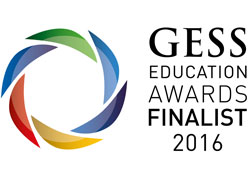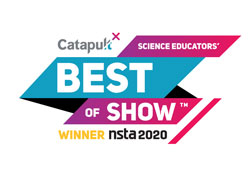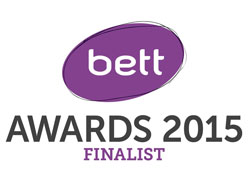















Measures intensity, absorbance, and transmittance across the visible spectrum. Includes fluorescent excitation at 405nm and 500nm.
- 10x Cuvettes
- 1x Spectrometry Software
See the Buying Guide for this item's required, recommended, and additional accessories.
Product Summary
The award-winning PASCO Wireless Spectrometer is specifically designed for introductory chemistry, biology, and physics labs. It pairs effortlessly with student devices (Mac®/Windows®, Chromebook™, iPad® and Android™ tablets) via Low Energy Bluetooth® (BLE) or USB and includes free PASCO Spectrometry Software for easy operation. Scan times are fast, ranging from milliseconds to minutes depending on the experimental settings. This enables students to quickly gather absorbance spectra across the visible spectrum. After specifying a target wavelength, students can select a display to compare absorption to concentrations (Beer's Law), track rates of reactions (kinetics), or investigate emission spectra using the optional Fiber Optic Cable accessory.
Overview
- Spectral scans from 390 to 950 nm
- Fluorescence excitation at 405 nm and 500 nm
- Intuitive, software-based operation
- Built-in tools for routine analyses
- Two-click (light/dark) brightness calibration
- NEW Frequency calibration ensures accuracy for the life of the unit
- Clear marks indicate light source and detector location for proper cuvette positioning
How Does it Work?
Light from the LED-boosted tungsten light source passes through the solution and into a slit sending light through a high-quality diffraction grating. Colors separate across a sensor and an image of the slit illuminate over 1000 sensors in the array on the other side of the spectrometer. The CCD array detects the brightness of each color of light so you can further analyze the brightness of each particular wavelength. When used with the optional Fiber Optic Cable, the Wireless Spectrometer can analyze light from emission spectroscopy experiments. Simply insert the Fiber Optic Cable into the cuvette holder and point the end of the cable at the light source to collect data.
Important Note: Solvents used within this spectrometer should be compatible with polystyrene (cuvette material) and ABS polymer (spectrometer housing material). Use either a glass cuvette or 12mm test tube for solutions with strong organic solvents like acetone, which will damage the plastic cuvettes and the interior of the spectrometer if spilled.
The PASCO Wireless Spectrometer is fully integrated with our user-friendly Spectrometry Software.
This free software is compatible with most student devices, enabling lab groups to quickly share and review their data with ease. Also available as a free, fully functional app, PASCO's cross-platform Spectrometry Software improves the efficiency of analyses with features such as:
- Easy-to-use navigation
- One-click light and dark (brightness) calibrations
- Soon to be released wavelength calibration will accommodate minor shifts from use
- Automatic display and storage of sample data
- Onboard scan averaging and data smoothing
- Intuitive run renaming for improved data tracking
- Spectral graph correlates visible wavelengths with color
- Built-in Beer-Lambert law with linear fits for determining concentrations
- Print spectrum and results snapshots
- Export data as a .csv file or .png screenshot for further analysis in Excel, SPARKvue, or PASCO Capstone
Spectrometry Software includes four configured displays:
- Analyze Solutions: Absorbance vs. Wavelength
- Compare Concentration: Absorbance vs. Concentration (Beer's Law)
- Change Over Time: Absorbance vs. Time (Kinetics)
- Analyze Exterior Light Sources: Intensity vs. Wavelength (Emission spectra)
Free Downloadable Spectroscopy Software
User's Guide and Help Documents
 |
 |
 |
Applications
- Determine the rate of an enzyme-catalyzed reaction
- Study the relationship between absorbance and concentration (Beer's Law)
- Monitor photosynthesis rates using DPIP
- Analyze the absorption spectra of photosynthetic plant pigments
- Monitor the growth of a cell culture
- Determine the concentration of protein in a solution
- Photosynthesis with algae beads using a pH indicator
Perform These Experiments
- Emission spectra of light from flame tests or fluorescent bulbs
- Easily identify peak wavelengths for concentration data
- Reaction kinetics
- Enzymatic reactions
- Determine colored solution concentrations
- Explore Le Chatelier's principal on reversible reactions
What's Included
- 10x Cuvettes
- 1x Spectrometry Software
Product Specifications
| Cuvette Material | Polystyrene |
| Wavelength |
|
| Photometric |
|
| Spectrometer Body Material | ABS plastic |
| Fluorescence Excitation Wavelengths | 405 nm and 500 nm |
| Industry Standard Cuvette Size | 12 x 12 x 45 mm, 10 mm inner path 3.5 ml |
| Light Source | LED-boosted tungsten |
| Operation & Light control | Software-based (via PASCO Spectrometry Software) |
| Connectivity | USB and Bluetooth 5.2 |
| Charging/ Data Port Type | Mini USB |
| Battery type | Rechargeable LiPo |
| Logging | No |
| Care for accuracy of unit | Plastic body susceptible to calibration shift if twisted or dropped. Units may be re-tuned at Pasco. |
Battery & Logging
| Stored Data Points Memory (Logging) 1 | Not Supported |
| Battery Type | Rechargeable LiPo |
1 Minimum # of data points with all measurements enabled, actual results depend on enabled measurements.
2 Continuous use in a connected state until battery failure, actual results will depend on sample rate, active measurements, and battery condition.
3 Logging until battery failure, actual results will depend on sample rate, active measurements, and battery condition.
* Normal classroom use is the sensor in active use for 20min/lab for 120 lab periods/yr.
Data Collection Software
This product requires PASCO software for data collection and analysis. We recommend the following option(s).
Connectivity Options
This product can connect directly to your computer or device with the following technologies. No Interface required. See the following guide for details regarding device compatibility: Wireless Bluetooth Product Compatibility »
- Bluetooth Low Energy (BLE)
- Universal Serial Bus (USB)
Dedicated Datalogging with SPARK LXi2
Consider an all-in-one, touchscreen data collection, graphing, and analysis tool for students. Designed for use with wired and wireless sensors, the SPARK LXi2 Datalogger simultaneously accommodates up to five wireless sensors and includes two ports for blue PASPORT sensors. It features an interactive, icon-based user interface within a shock-absorbing case and arrives packaged with SPARKvue, MatchGraph!, and Spectrometry software for interactive data collection and analysis. It can additionally connect via Bluetooth to the following interfaces: AirLink, SPARKlink Air, and 550 Universal Interface.
Buying Guide
| Recommended Accessories | P/N | Price |
|---|---|---|
| Free Spectrometry Software | -- | -- |
| Fiber Optic Cable Accessory used for collection of emission spectra | PS-2601 | -- |
| Wireless Sensor Charging Station Recommended charging solution for multiple sensors | PS-3599 | -- |
| Replacement Parts | P/N | Price |
|---|---|---|
| Cuvettes and Caps | SE-8739 | -- |
| USB Connection Cable | PS-2528 | -- |
| Also Available | P/N | Price |
|---|---|---|
| Cuvette Rack | EC-3590 | -- |
| USB Bluetooth Adapter Required by older computers without bluetooth 4.0 or later | PS-3500 | -- |
Product Guides & Articles
AP Biology Lab Manual Overview
PASCO’s award-winning teacher guide, Advanced Biology Through Inquiry Teacher Lab Manual, includes eighteen guided inquiry labs that cover AP Biology concepts such as osmosis and diffusion, evolution, energetics, and system interactions.
AP Chemistry Lab Manual Overview
Authored by chemistry educators, the Advanced Chemistry Through Inquiry Teacher Lab Manual includes sixteen guided inquiry labs that cover AP Chemistry course concepts such as Moles and Molar Mass, Stoichiometry, and Reaction Rates.
Spectrometers
A spectrometer is a device that allows scientists to dissect light into its constituent colors, akin to separating the vibrant hues of a rainbow. By precisely dispersing the light, spectrometers provide a unique window into the physical and chemical properties of objects.
Spectroscopy
Spectroscopy is the investigation and measurement of spectra produced by matter interacting with or emitting electromagnetic radiation. During a spectroscopy experiment, electromagnetic radiation of a specified wavelength range passes from a source through a sample containing compounds of interest, resulting in absorption or emission.
Lab Activities & Experiments
| Analyzing the Absorption Spectrum of Leaves | 57.07 KB | |
| Beer’s Law Sample Lab | 91.89 KB | |
| Enzyme Activity | 96.70 KB | |
| Kinetics Sample Lab | 538.18 KB | |
| Light Analysis | 177.56 KB | |
| Percent Copper in Brass Sample Lab | 107.28 KB | |
| Spectrometer Sample Data | 158.37 KB |
Experiment Library
Perform the following experiments and more with the Wireless Spectrometer (Vis).
Visit PASCO's Experiment Library to view more activities.
Investigating Photosynthesis with Algae Beads
Students will use a Wireless Spectrometer, algae beads, and bicarbonate indicator to investigate the photosynthetic activity of algae and the effect on freshwater pH.
Kinetics of Crystal Violet Fading (Spectrometer)
Students determine the reaction order of crystal violet fading in the presence of sodium hydroxide.
Measuring The Speed Of A Reaction
Students use a spectrometer to determine the order of a reaction and the effect of variables on the reaction rate.
Investigating the Copper Content of Brass (Spectrometer)
This lab extends knowledge of the electromagnetic spectrum, spectrometry and colorimetry. Students use Beer's law and generate a calibration curve to determine the copper content of a sample of brass. Students are expected to...
Plant Pigments
Students analyze spinach pigments and chloroplasts using paper chromatography, a colorimeter, and a spectrometer to understand how plants capture light for photosynthesis.
Light, Color, and Concentration
In this lab, students use a spectrometer to learn how to use visible light to determine the concentration of colored ion species in a solution.
Plant Pigments
In this lab, students will extract pigments from spinach leaves and analyze their samples using chromatography and colorimetry.
Chemical Equilibrium
Students use the results of a spectrometer and a temperature sensor to control the direction of a reversible chemical reaction.
Enzyme Activity (Spectrometer)
Students use a spectrometer to investigate the catalyzed breakdown of hydrogen peroxide by peroxidase.
Hydrogen Emission and Absorption Spectra
Students use a spectrometer, fiber optics cable, a hydrogen gas spectrum lamp, and the sun to compare emission and absorption lines, study atomic structure, associate light energy and wavelength with electron transitions, and...
Investigating the Copper Content of Brass (Colorimeter)
This lab extends knowledge of the electromagnetic spectrum, spectrometry and colorimetry. Students use Beer's law and generate a calibration curve to determine the copper content of a sample of brass. Students are expected to...
Percent Copper in Brass (Spectrometer)
Students use a spectrometer to create a Beer's law plot of known copper solution concentrations from which the unknown percent of copper in a brass sample can be determined.















